Source: MIL-OSI Submissions

International travel and migration patterns shift due to COVID-19 pandemic – Media release
12 August 2020
COVID-19 international travel restrictions saw New Zealand’s border crossings fall sharply, alongside a slowdown in migration in the June 2020 quarter, Stats NZ said today.
Total border crossings fall significantly
The total number of border crossings in the June 2020 quarter was 78,400, down from 3.14 million for the same period in 2019.
There were 57,200 departures and almost 90 percent of these were non-New Zealand citizens.
There were 21,100 arrivals, which includes a mix of short-term travellers and migrants (see ‘Arrivals by passenger type’ flowchart in International migration: June 2020).
“The majority of people arriving in recent months are New Zealand citizens, however the numbers are low compared with arrival flows before strict border restrictions came into force on 19 March 2020,” population indicators manager Tehseen Islam said.
Two-thirds (14,300) of arrivals were New Zealand citizens. Half (7,100) of those were returning from a short-term trip overseas, and half (7,200) were arriving after living overseas for more than 12 months.
“Of the 7,200 who have been living overseas it remains to be seen how many will either return overseas, or stay long-term and in time be classed as migrants,” Mr Islam said.
Not all of the recent arrivals will stay long enough to be classed as migrant arrivals. Provisional migration estimates indicate 2,500 could stay beyond a year.
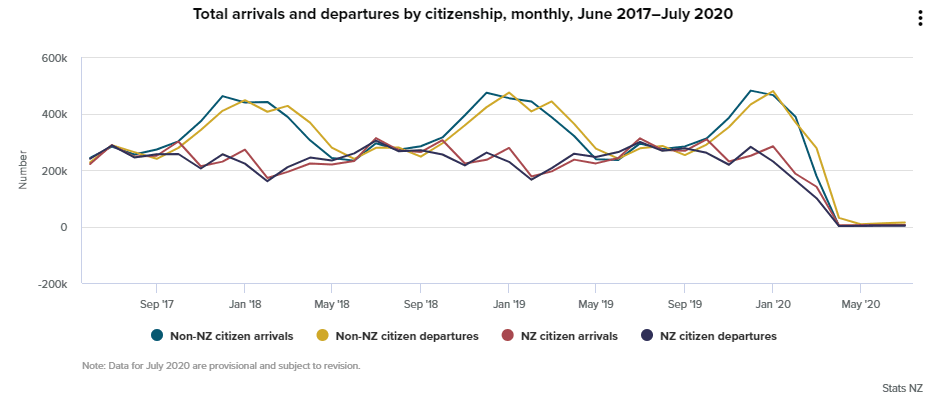
New Zealand citizen migration adds to net migration
Provisionally, 45,500 New Zealand citizens arrived as migrants in the year ended June 2020, while 28,500 emigrated over the same period.
As a result, there was a provisional net migration gain of 16,900 New Zealand citizens in the year ended June 2020. About 80 percent (13,900) of the gain was in the six months leading up to border and travel restrictions.
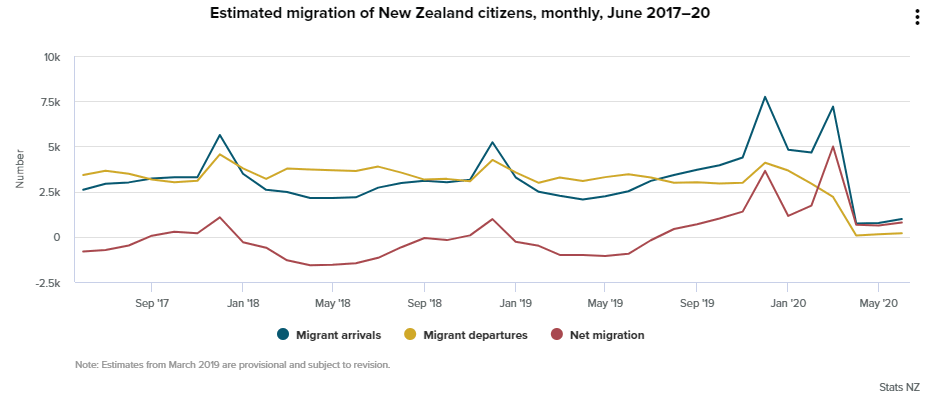
Net migration of New Zealand citizens was higher than usual up to March, as those who arrived in late 2019 and early 2020 decided to stay or were unable to depart.
Since March there have been relatively few New Zealand-citizen migrant departures, which also contributed to the net migration gain.
“New Zealand citizens may have been unable or reluctant to head offshore due to international travel restrictions and the evolving global pandemic,” Mr Islam said.
“The net gain of New Zealand citizens over the last year reverses the long-standing historical pattern where more New Zealand citizens depart than arrive.”
Over the previous 18 years ended June 2002–19, net migration of New Zealand citizens averaged a loss of 19,700 a year.
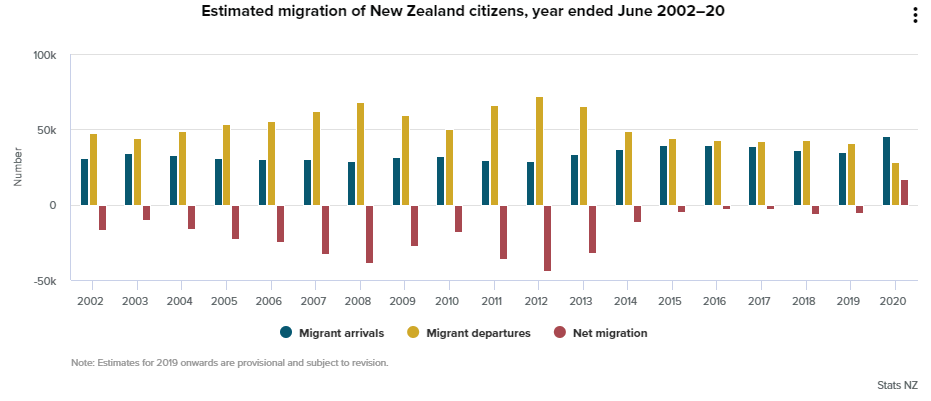
Non-New Zealand citizens still dominate overall migration flows
Among non-New Zealand citizens there were provisionally 108,500 migrant arrivals, 46,000 migrant departures, and 62,500 net migration in the year ended June 2020.
However, recent monthly flows have dropped dramatically with migration estimates indicating a small net loss (1,300) over the June quarter.
This is the only net loss of non-New Zealand citizens in the outcomes-based migration estimates, available from 2001 onwards.
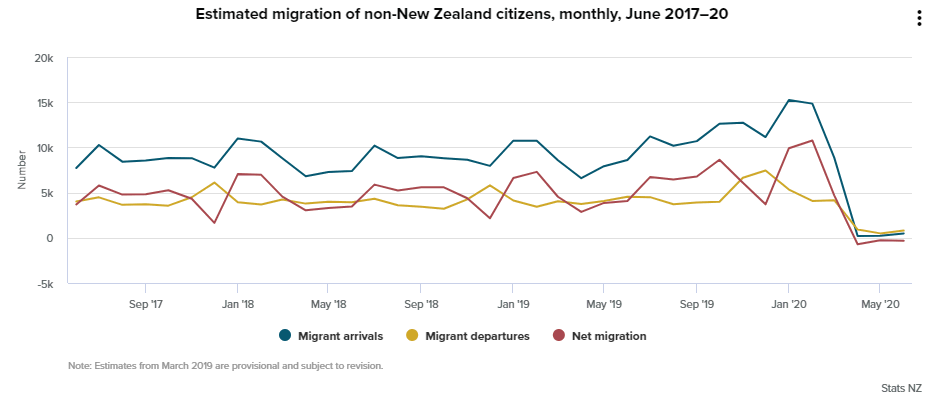
Overall net migration low in recent months
Net migration for the months of April, May, and June 2020 was provisionally zero, 400, and 500, respectively, as a result of border and travel restrictions related to the COVID-19 pandemic.
Despite low migration in recent months, provisional estimates for the year ended June 2020 show annual net migration at 79,400. Three-quarters (57,700) of this was in the six months leading up to travel and border restrictions.
“Thousands of people who arrived in New Zealand since late 2019 have not yet returned home, and are staying longer than usual,” Mr Islam said.
“Net migration estimates could be revised up or down depending on whether these people stay in New Zealand or head back overseas.”
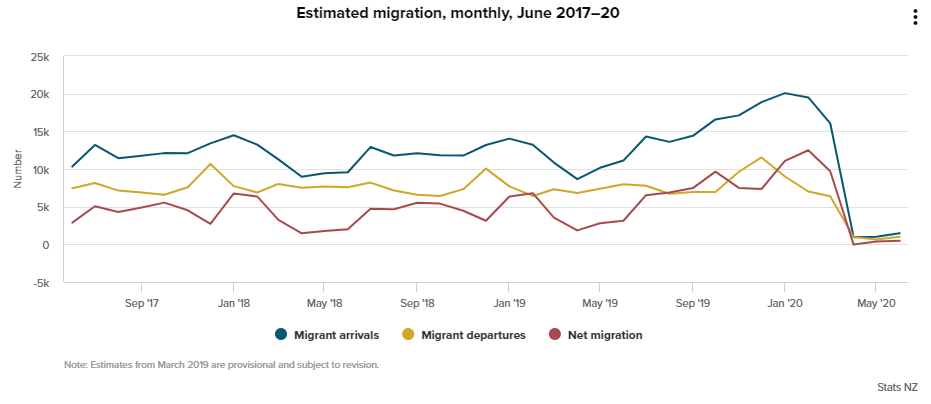
Provisional migration estimates for recent periods are less certain than estimates for older periods. Estimated net migration for the year ended December 2019 is 69,800. Net migration provisionally reached a peak of 86,400 in the year ended March 2020.
Net migration for the year ended February 2019 has now been finalised at 49,500.
Who is a migrant?
‘Migrant arrivals’ are overseas residents, including New Zealand citizens living overseas, who cumulatively spend 12 of the next 16 months in New Zealand after arriving.
‘Migrant departures’ are New Zealand residents, including non-New Zealand citizens living in New Zealand, who cumulatively spend 12 of the next 16 months out of New Zealand after departing.
Migrant arrivals and departures include the flows of New Zealand citizens as well as the flows of non-New Zealand citizens as both affect the population living in New Zealand.
The classification of travellers as migrants is based on their time spent in and out of New Zealand, not what visa type or passport they cross the border on, and not on their responses on arrival cards. Given this, we need to observe up to 16 months of travel history, using the 12/16-month rule, to definitively classify a border crossing as a migrant movement. Border crossing data after June 2020 therefore informs the latest migration estimates.
Key travel restrictions timeline
2 February 2020: New Zealand Government placed entry restrictions into New Zealand on all foreign nationals travelling from or transiting through mainland China (see New Zealand to restrict travel from China to protect against coronavirus).
2 March 2020: Travel restrictions for China and Iran to continue, and people entering the country from South Korea and northern Italy told to go into self-isolation (see Travel restrictions reconfirmed as precaution against COVID-19).
14 March 2020: Every person entering New Zealand from anywhere in the world required to self-isolate for 14 days, excluding the Pacific.
19 March 2020: New Zealand’s borders closed to almost all travellers, except for returning New Zealanders (see Stronger border measures to protect NZers from COVID-19) and New Zealanders advised not to travel overseas (see New Zealanders advised not to travel overseas).
24 March 2020: Tens of thousands of New Zealanders travelling overseas advised to shelter in place (see New Zealanders overseas encouraged to shelter in place).
2 April 2020: New Zealand Government announced that domestic travel restrictions would be relaxed to facilitate the departure of overseas visitors (see Managed departure plan for stranded foreign nationals enables safe, orderly exit).
7 April 2020: New Zealand Government announced New Zealand to enter into transit arrangements with a number of countries to make it easier for each other’s citizens to get home (see Managed transit allows stranded travellers to get home).
9 April 2020: New Zealand Government announced mandatory 14 day quarantine for all arrivals (see Prime Minister’s remarks halfway through Alert Level 4 lockdown).
7 July 2020: New Zealand Government announced bookings on incoming Air New Zealand flights to be managed to align arrival numbers with capacity available in managed isolation and quarantine facilities (see Government and Air New Zealand agree to manage incoming bookings).



